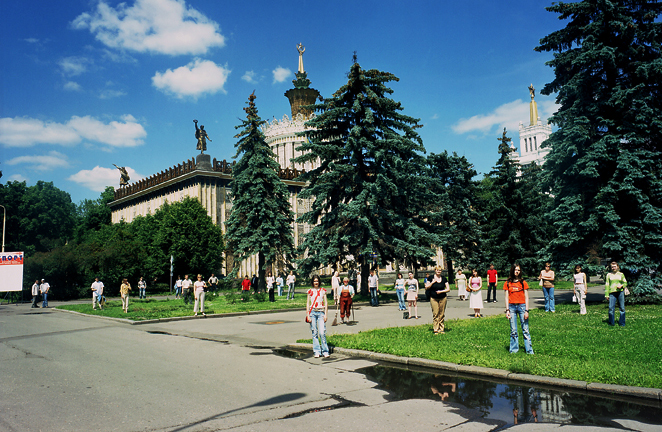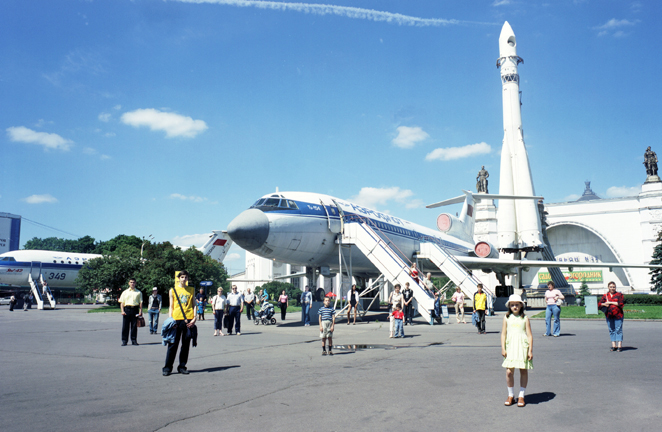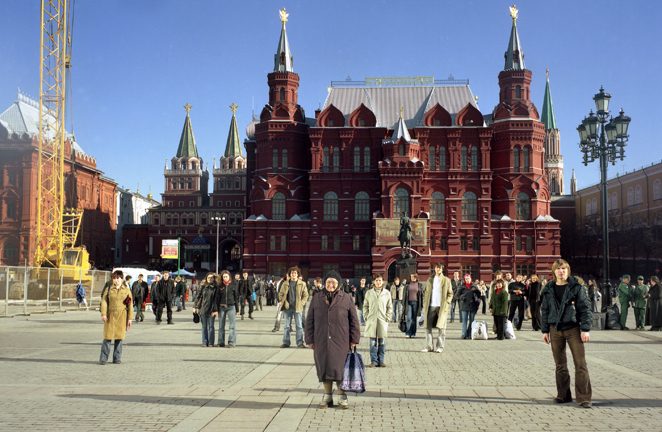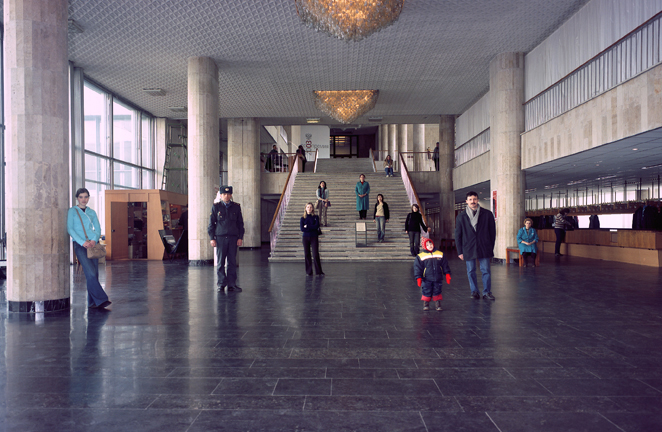I first came across Melanie Manchot's work 10 years ago in issue 41 of Portfolio Catalogue. I was interested in her work from Moscow, Groups + Locations (Moscow) 2004. "
Melanie describes the project on her site...
"Groups + Locations (Moscow)', is a series of photographs taken at historic sites in and around Moscow. Based on late 19th century group shots, the work refers to a moment when photography played an important role in the Russian people’s comprehension of what their vast lands and its inhabitants looked like. Groups + Locations takes the vernacular of historic group portraiture as a cue for structuring contemporary images that are similarly striking in the intensity of a given group collectively directing their gazes, their looking focused by the camera. In a culture where photography is still prohibited in many designated public spaces, the participation of the passers-by and the resulting images develop a political charge. The work proposes a performative approach to portraiture, raising questions about individual and cultural identities, as well as public space as a framework for a participatory practice."
At the time I was researching for my final year project which drew on British stereotypes and culminated in a staged group portrait based on observations of people queuing.

Melanie gave a visiting lecture about her work and I remember being impressed by the her ability to gain access and trust within different community groups.
[gallery ids="50225,50221,50227,50229,50223"]
When I graduated I started assisting Melanie and we still work together now. At the time she had just finished filming her
Film and Video Umbrella commission developed in collaboration with
Whitechapel Gallery -
Celebration (Cyprus Street). Unfortunately she had already filmed the 35mm tracking shot that moves through a street party on Cyprus Street culminating in a durational group portrait that investigates the relationship between still and moving images. Alongside the film Melanie made a series of portraits providing a more intimate insight into the diverse East End community. I assisted her on some of these and started to observe how she gains trust. Over the years I have learnt that fully exploring a subject is common in Melanie's work. She throughly investigates her theme through photography and film amassing an amazing amount of content that contributes to rich installations.
It was about this time that I started working on my 3 year project
Firedive. The project focussed on La Vallette tidal bathing pools in Guernsey and I worked with the local community of swimmers to create a portrait of the pools digging into it's rich history and creating the first moving image work I made. The film explored ideas of collective memory in relation to swimming galas, torchlight processions and 'firedives' that took place during the 1970's. Melanie was a brilliant mentor and her support allowed me to develop my relationships with this community to create a vast multilayered investigation. During the second year of the project I organised a swimming gala at the pool and premiered the film in a open air poolside screening at the end of the night.
[gallery ids="50243,50235,50237,50239,50241,50245,50247"]
Since then I have worked on Melanie's
Great North Run Moving Image Commission. Melanie decided to trace the route of the famous half marathon by working with a local crew of young parkour runners. We filmed over the period of a year as Melanie wanted to explore the landscape through all seasons. This was the first time I was involved in the production of a whole project and it was a fantastic insight into how Melanie builds and develops relationships within specific communities not to mention the incredible access she secures. We had the GNR team on board so access was made easier however Melanie's ability to gain trust and secure access to incredible locations cannot be underestimated. We began filming on the motorway and our journey took in Newcastle and Gateshead's iconic landmarks such as the roof of the Sage, the swing bridge, Tyne Bridge Towers, Tyne Tunnel, Gateshead International Stadium not to mention numerous roof tops, allotments and farmland.
The Apeuro Parkour crew were amazing and fully supported Melanie's vision. Alongside access the trust of participants is paramount and allows space to fully interrogate an idea. The young crew worked through all seasons and harsh conditions to deliver a view of parkour removed from the MTV or James Bond representations.
Here is Melanie's synopsis for
Tracer ...
"Tracer presents a journey that re-frames and choreographs an alternative movement of bodies and cameras through urban and rural landscapes. The film draws attention to how human agency may act upon built environments and questions the authority inherent to architectural form. Through the actions of a group of parkour runners and the structures that support their movements, a reciprocal connection between the individual, the collective and the environment is made. Filmed in continuous tracking and panning shots the camera observes the parkourists as they investigate each space for its potential to yield particular forms of physical engagement. The use of long, slow sequences and pulled back views intends to remind the viewer of the ever-present position of surveillance within the public sphere. The deliberately detached point of observation and the perceived sense of authority it instils is juxtaposed with close ups, focusing on moments of connection between bodies, both human and architectural. Filmed mostly at dusk and dawn, the work posits a view of the city on the margin of regular time, which the parkourists occupy like a sub-cultural tribe, a pack. The film’s interest in parkour focuses on how it functions as a non-competitive discipline or practice. Also referred to as the ‘art of displacement’, parkour aims to change the perception of urban space and questions our ability to place and move our bodies in relation to structures that define our environments. Parkour is practiced as a state of mind rather than a set of actions, and is about overcoming and adapting to mental and emotional obstacles as well as physical barriers. It is in the relation between the movement of the camera and that of the parkour runners that Tracer aims to present a performativity of space and our own potential choreographies within this."
Tracer was an amazing project to be part of and highlighted what it is possible to achieve with such a small crew. It was always just Melanie Directing, cinematographer Bevis Bowden and myself generally assisting, camera assisting, lighting and recording sound.

More recently we have all worked together on Melanie's latest project
Twelve. This was the second time I have been involved for the whole production and once again it was truly inspiring to see how she extensively works this time with the sensitive subject of addiction. She formed relationships with recovering addicts to create a multi channel video installation exploring the intimate stories, rituals, repetitions and ruptures of lives spent in addiction and recovery. Once again the volume of content generated from one project is staggering as is the commitment and generosity of the participants in sharing their stories.
Twelve is going to be a stand alone website
http://www.twelve.org.uk/ and will be on show at Peckham Platform, London from 22nd May - 26th June. Read the full press release here:
http://www.twelve.org.uk/MM-Twelve-Press-Release-7a.pdf

 More recently we have all worked together on Melanie's latest project Twelve. This was the second time I have been involved for the whole production and once again it was truly inspiring to see how she extensively works this time with the sensitive subject of addiction. She formed relationships with recovering addicts to create a multi channel video installation exploring the intimate stories, rituals, repetitions and ruptures of lives spent in addiction and recovery. Once again the volume of content generated from one project is staggering as is the commitment and generosity of the participants in sharing their stories.
Twelve is going to be a stand alone website http://www.twelve.org.uk/ and will be on show at Peckham Platform, London from 22nd May - 26th June. Read the full press release here: http://www.twelve.org.uk/MM-Twelve-Press-Release-7a.pdf
More recently we have all worked together on Melanie's latest project Twelve. This was the second time I have been involved for the whole production and once again it was truly inspiring to see how she extensively works this time with the sensitive subject of addiction. She formed relationships with recovering addicts to create a multi channel video installation exploring the intimate stories, rituals, repetitions and ruptures of lives spent in addiction and recovery. Once again the volume of content generated from one project is staggering as is the commitment and generosity of the participants in sharing their stories.
Twelve is going to be a stand alone website http://www.twelve.org.uk/ and will be on show at Peckham Platform, London from 22nd May - 26th June. Read the full press release here: http://www.twelve.org.uk/MM-Twelve-Press-Release-7a.pdf





